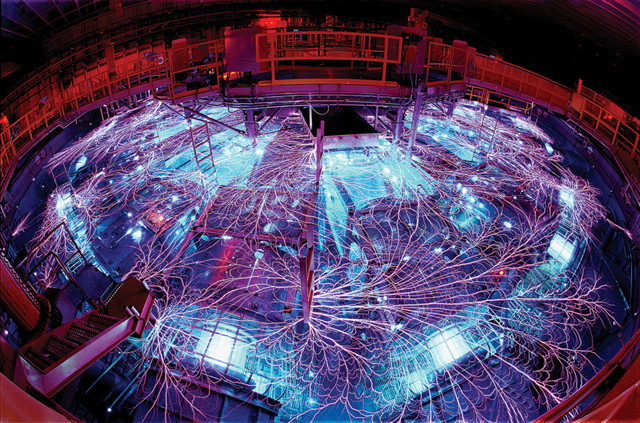
by Mary Caperton Morton Friday, July 17, 2015

The Z machine in Albuquerque is roughly 30 meters across and is used to generate electric currents of up to 20 million amps. Credit: Randy Montoya.
Iron is one of the most common elements in the Earth’s mantle and core, most of it having come from massive collisions with asteroids and other would-be planets as the early solar system took shape. But why our planet’s rocky mantle contains so much of the metal, which theory suggests should have sunk to the core, has left researchers stumped. Now, with the help of the world’s largest radiation source, scientists have replicated the conditions of early planetary formation to take a closer look at how Earth’s iron-rich mantle — and the moon’s conversely iron-poor mantle — came to be.
The cryptic-sounding Z machine at Sandia National Laboratories in Albuquerque, N.M., is a giant capacitor bank capable of producing electrical pulses more powerful than twice the world’s total electrical generating capacity. By harnessing this power to launch aluminum plates into iron targets at extreme velocities, a team led by Richard Kraus of Harvard University generated the shock pressures necessary to vaporize iron for the first time.
Although the forces needed to vaporize iron in the experiments were high, they weren’t as great as theoretical models had predicted. “It turns out it’s really quite easy to vaporize iron, requiring about half the pressure that models had estimated,” Kraus says. He and his colleagues reported in Nature Geoscience that vaporization occurred at shock pressures as low as 507 gigapascals, far below the predicted 887 gigapascals.
The higher shock pressure presumed until now to be needed to vaporize iron suggested to scientists that most of the iron delivered to Earth in collisions with other planetary bodies and space debris would not have been vaporized. Instead, the thinking went, it would have penetrated to Earth’s core as a coherent molten mass, limiting the extent of mixing between the newly arrived iron and Earth’s mantle.
But the new results imply that “vaporization was happening all the time during these impact events,” Kraus says. Rather than newly arrived iron sinking directly to Earth’s growing core, the iron would have “vaporized and spread over the surface within a vapor plume,” Kraus says. This vapor would’ve eventually condensed into a sort of iron rain and fallen back to the planet, where it could then “mix much more easily with Earth’s mantle.”
The lower vaporization point for iron also helps solve a long-standing mystery about the composition of the moon, says William Anderson, a physicist at Los Alamos National Laboratory in Los Alamos, N.M., who was not involved in the new research. Compared to Earth, the moon has lower concentrations of iron and other elements that tend to associate with iron — such as iridium, nickel and gold — although both objects should have been subjected to the same iron-rich bombardments during the later stages of formation, he says.
“If both bodies received a late delivery of iron-rich material, why is this material missing from the Moon?” Anderson asked in an accompanying commentary in the same issue of Nature Geoscience. “The physical behavior of iron during a giant impact event offers an answer: the high velocities in vapor plumes result in the preferential loss of impactor material from smaller bodies with lower gravity,” he wrote. So, though the moon may have received the same dose of iron, its lower gravity couldn’t hold onto the vaporized metal and it escaped into space, leaving the moon iron-poor.
Next, Kraus and his colleagues plan to use the Z machine to test the shock pressure properties of other important early-Earth compounds such as magnesium oxide and quartz. “If we can use actual experimental data to predict the behaviors of materials during and after a giant impact, it will help us to better describe the process of planet formation.”
The Z machine work should keep the team busy for some time, as little is known about the behavior of most elements under extreme conditions, Anderson says. There is “a long to-do list,” he says, “pretty much the whole periodic table.”
© 2008-2021. All rights reserved. Any copying, redistribution or retransmission of any of the contents of this service without the expressed written permission of the American Geosciences Institute is expressly prohibited. Click here for all copyright requests.